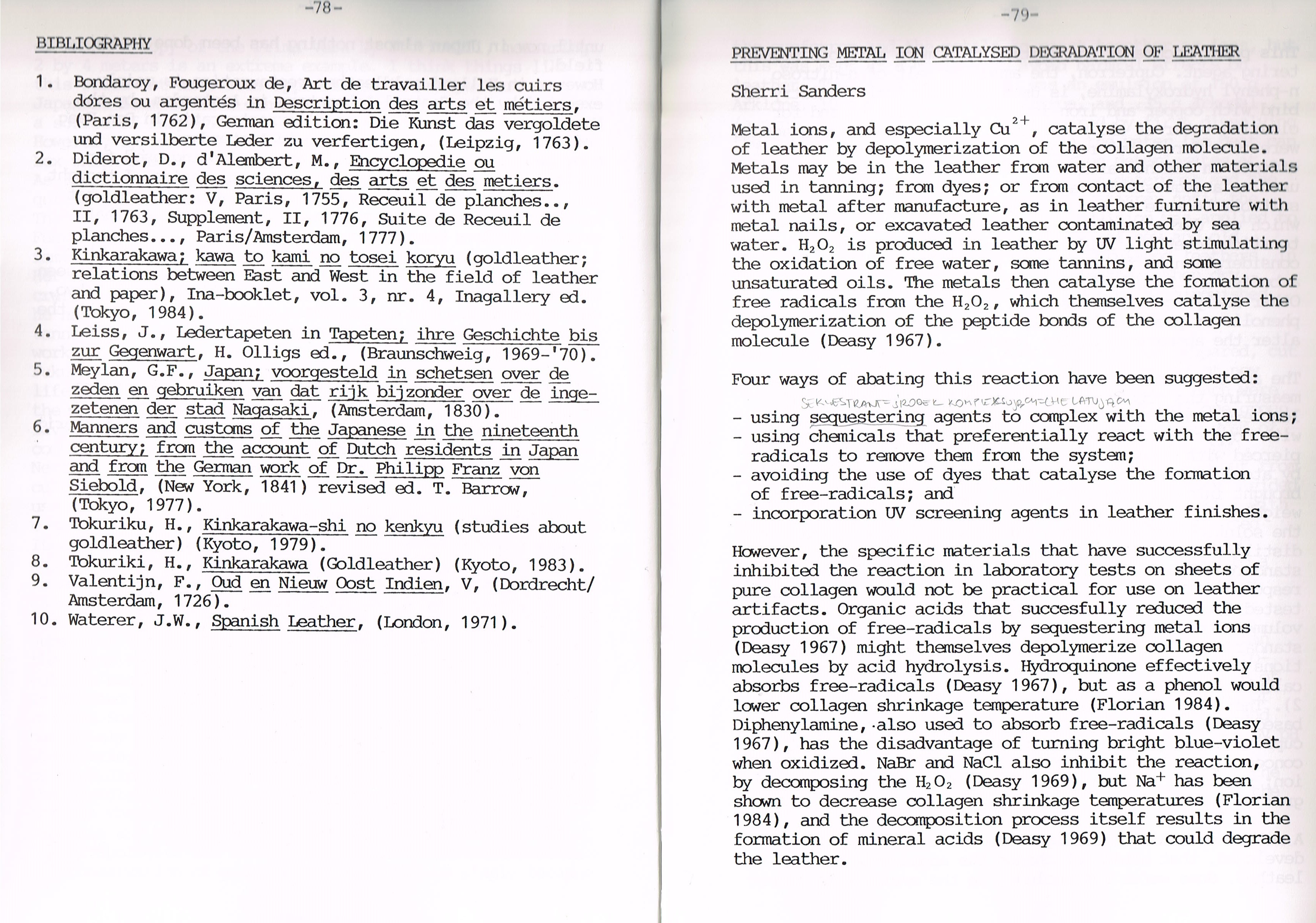CCI20140507�42

-78-
BIBLIOGRAPHY
1. Bondaroy, Fougeroux de, Art de travailler les cuirs dóres ou argentes in Description des arts et metiers, (Paris, 1762), German edition: Die Kunst das vergoldete und versilberte Leder zu verfertigen, (Leipzig, 1763).
2. Diderot, D., d'Alembert, M., Encyclopedie ou dictionnaire des Sciences, des arts et des metiers. (goldleather: V, Paris, 1755, Receuil de planches..,
II, 1763, Supplement, II, 1776, Suitę de Receuil de planches..., Paris/Amsterdam, 1777).
3. Kinkarakawa; kawa to kami no tosei koryu (goldleather; relations between East and West in the field of leather and paper), Ina-booklet, vol. 3, nr. 4, Inagallery ed. (Tokyo, 1984).
4. Leiss, J., Ledertapeten in Tapeten; ihre Geschichte bis zur Gegenwart, H. Olligs ed., (Braunschweig, 1969-'70).
5. Meylan, G.F., Japan; yoorgesteld in schetsen over de zeden en gebruiken van dat rijk bij zonder over de inge-zetenen der stad Nagasaki, (Amsterdam, 1830).
6. Manners and customs of the Japanese in the nineteenth century; from the account of Dutch residents in Japan and from the German work of Dr. Philipp Franz yon Siebold, (New York, 1841) revised ed. T. Barrow,
(Tokyo, 1977).
7. Tokuriku, H., Kinkarakawa-shi no kenkyu (studies about goldleather) (Kyoto, 1979).
8. Tokuriki, H., Kinkarakawa (Goldleather) (Kyoto, 1983).
9. Valentijn, F., Oud en Nieuw Post Indien, V, (Dordrecht/ Amsterdam, 1726).
10. Waterer, J.W., Spanish Leather, (London, 1971).
PREVENTING METAL IOSI CATALYSED DEGRADATION OF LEATHER
Sherri Sanders
2 -J-
Metal ions, and especially Cu , catalyse the degradation of leather by depolymerization of the collagen molecule. Metals may be in the leather from water and other materials used in tanning; from dyes; or from contact of the leather with metal after manufacture, as in leather fumiture with metal nails, or excavated leather contaminated by sea water. H202 is produced in leather by UV light stimulating the oxidation of free water, sonę tannins, and some unsaturated oils. The metals then catalyse the formation of free radicals from the H202, which themselves catalyse the depolymerization of the peptide bonds of the collagen molecule (Deasy 1967).
Four ways of abating this reaction have been suggested:
- using seguęstering agents to complex with the metal ions;
- using Chemicals that preferentially react with the free-radicals to remove them from the system;
- avoiding the use of dyes that catalyse the formation of free-radicals; and
- incorporation UV screening agents in leather finishes.
However, the specific materials that have successfully inhibited the reaction in laboratory tests on sheets of pure collagen would not be practical for use on leather artifacts. Organie acids that succesfully reduced the production of free-radicals by seąuestering metal ions (Deasy 1967) might themselves depolymerize collagen molecules by acid hydrolysis. Hydroąuinone effectively absorbs free-radicals (Deasy 1967), but as a phenol would lower collagen shrinkage temperaturę (Florian 1984).
Diphenylaminę,-also used to absorb free-radicals (Deasy 1967), has the disadvantage of tuming bright blue-violet when oxidized. NaBr and NaCl also inhibit the reaction, by decomposing the H202 (Deasy 1969), but Na+ has been shewn to decrease collagen shrinkage temperatures (Florian 1984), and the decomposition process itself results in the formation of minerał acids (Deasy 1969) that could degrade the leather.
Wyszukiwarka
Podobne podstrony:
78 Bibliographie 688. OZOUF (Mona). — Pourąuoi 1’ćcole de Jules Ferry divise
Bibliographie Au bas de ISchelle, Contrer le harcelement psychologique au travail: une question de d
*298 BULLETIN DE DOCUMENTATION BIBLIOGRAPHIQUE a le merite cTenoncer en termes simples les multiples
BULLETIN DE DOCUMENTATION BIBLIOGRAPHIQUE#3l6 Tindication de Tessentiel de ce qu’il faut voir. Un «
BULLETIN DE DOCUMENTATION BIBLIOGRAPHIQUE #320 et de la colonisation de rAmeriąue du Nord depuis la
Gazeta AMG nr 4/2014 Otwarcie wystawy w Bibliotece GłównejAndreasa Vesaliusa De humani corporis fabr
78 Annuaire dc la Commission du droit International. 1975. vol. II ou Pomission de ceux-ci". Le
bibliographie CIS morale avaient commencś de travailler avant 1973. annśe de la premiśre in-spection
35 NOTICES BIBLIOGRAPHlQUES 317 pedelem, de menie que la lutle des Albanais contrę certames mesurcs
78 De plus, les gestionnaires pcuvent trouver la tache lourde, car ils doivent remplir beaucoup plus
6 Art. 54. Dans leur seance de mai, les Classes designent pour chaque question trois membres ch
14 L’education dans la Pćninsule iberiąue bibliotheąues y rćvelent l’existence de psautiers pour
Bibliografia 275 projetation de ramenagement hydrauliąue et des constructions hydrauliąues, Gospodar
r LES RELATIONS ENTRE UBRAIRES ET BIBLIOTHĆCAIRES Un achat de livres est un acte eminemment
UN PROGRAMME TRIENNAL DE RENOVATION Les bibliołheques publiques ongloises sont financees por les imp
•64 REYISTA BIBLIOGRAFIA naquela classe de Vertebrados, mencionando as dimensóes dos canais e a sua
106 Bibliographie archćologiąue franęaise de Jćrusalem. —Acadćmie des Inscriptions et Belles-Lettres
Bibliographie 113 65. Conditions de vie et de travail des maftres 1019. DELWASSE (Lilianę). — Guy Ba
więcej podobnych podstron